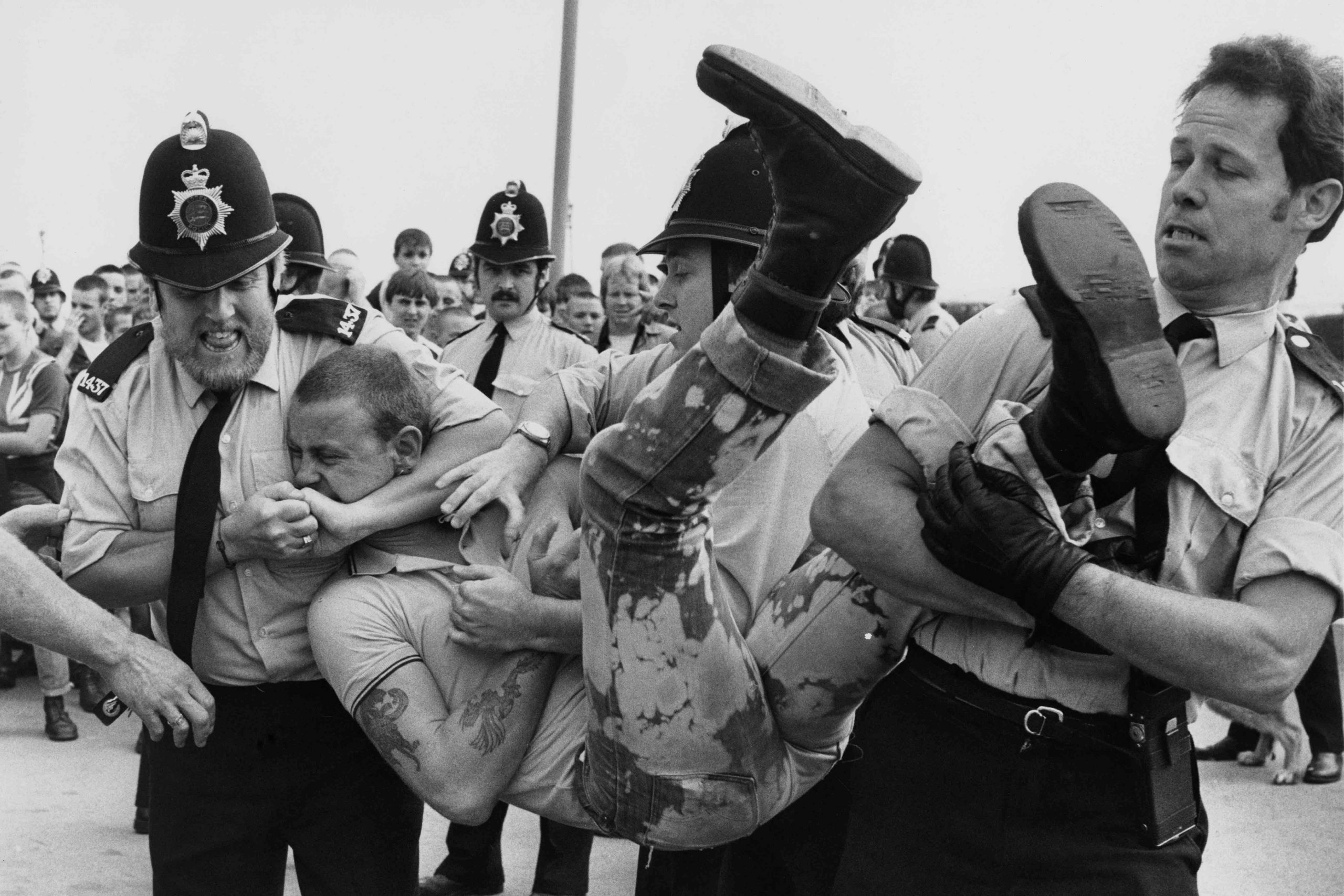Photographer Dave Benett on shooting skinhead punch-ups
- Text by Dave Benett
- Photography by Dave Benett

Although I’m now known as a showbiz photographer, I actually come from a newspaper background. I could easily have been a war correspondent if things had gone that way.
As a young news photographer circa 1977 through to 1985, I would be doing every big news story around England. From the Brixton riots and the Tottenham riots, to big cases at the Old Bailey. I have a famous picture of the Scottish serial killer Dennis Nielsen called ‘Eyes of a Killer’. I followed football hooligans to away matches, like when West Ham played Chelsea – quite tough games in those days.
That’s a young man’s game. You do that for the first five or six years, then you start thinking about doing something a little gentler. Although, when you’re in the middle of fans chasing Michael Jackson, that’s pretty rough too.
The big story of that period was the rebirth of the ’60s phenomenon known as the Teddy Boys vs the Rockers. It reappeared again in the early ’80s as the Skinheads against the Rockers. This was sort of at the height of it.
Historically, the big punch-up was always in Southend, Blackpool or Brighton. Gangs of skinheads would organise with each other to go down, and so would the Teddy Boys. If you think of Quadrophenia, that’s pretty much it. It was known that they would be there on a Bank Holiday Monday, so if you wanted a punch-up, that’s where you went.
I was sent by The Sun to go down there. I drove my little car down, parked up at the train station, which is where it always started, and went looking for the action. They’d appear from all around England and go to the pier to start punch-ups.
The police were very, very tuned into all this, so they’d usually catch them before they got into any big trouble and herd them towards the seaside front. They wouldn’t realise they were actually being herded to a dead end. Then they’d herd them, like a football crowd, back to the station and throw them back on the train.
Once I was talking to a policeman and I said, ‘Oh, God, this must be a real pain?’ And he said ‘No, we’re used to it. They don’t even buy a return ticket because they know they’re gonna get herded back to the train and get thrown back on it for free!’
These guys would go around literally looking for a fight. They could have a fight in a bathroom, they’d terrify people walking their children in prams, running up and down to the prom starting fights. Back in those days, the civil disorder was not for any good cause, it was just for vandalism and yob-ism. Whereas nowadays, we’re seeing a politicised situation where people are rioting for a cause which is a lot different.
What I love about this shot is the sort of toughness of the police at the same time – they both reflected on each other. These guys were troublemakers, and the police weren’t going to mess about. You can see, there’s a crowd of about 200 skinheads there. The police picked on a ringleader, grabbed him and pulled him out.
As I’m taking this picture, I heard someone say: ‘Great shot, kid.’ I turn around and over my left shoulder is Don McCullin, who is like the greatest war photographer England’s ever had. I couldn’t believe it. He didn’t know who I was, he just said it. Obviously, my picture ran in The Sun with no byline, his picture was probably on a double page spread in The Sunday Times.
Whether you’re capturing a news moment like this or photographing a celebrity, having an eye that sees a great picture is obviously still important. Hopefully, that’s something you never lose. These things happen in an instant, daily, and you’ve got to be ready for it. Someone might be standing right next to you but they won’t get that same picture. It’s a dark art.
(As told to Gary Grimes)

Skinheads in Southend (1981) – Dave Benett
See more of Dave Benett’s work on his official website.
You might like

Largest-Ever Display of UK AIDS Memorial Quilt Opens at Tate Modern
Grief Made Visible — Comprising hundreds of panels made by lovers, friends and chosen family, the UK AIDS Memorial Quilt returns in full for the first time since 1994 – a testament to grief, friendship and the ongoing fight against HIV stigma.
Written by: Ella Glossop

In Medellín’s alleys and side streets, football’s founding spirit shines
Street Spirit — Granted two weeks of unfettered access, photographer Tom Ringsby captures the warmth and DIY essence of the Colombian city’s grassroots street football scene.
Written by: Isaac Muk

Remembering New York’s ’90s gay scene via its vibrant nightclub flyers
Getting In — After coming out in his 20s, David Kennerley became a fixture on the city’s queer scene, while pocketing invites that he picked up along the way. His latest book dives into his rich archive.
Written by: Miss Rosen

On Alexander Skarsgård’s trousers, The Rehearsal, and the importance of weirdos
Freaks and Finances — In the May edition of our monthly culture newsletter, columnist Emma Garland reflects on the Swedish actor’s Cannes look, Nathan Fielder’s wild ambition, and Jafaican.
Written by: Emma Garland

Why Katy Perry’s space flight was one giant flop for mankind
Galactic girlbossing — In a widely-panned, 11-minute trip to the edge of the earth’s atmosphere, the ‘Women’s World’ singer joined an all-female space crew in an expensive vanity advert for Jeff Bezos’ Blue Origin. Newsletter columnist Emma Garland explains its apocalypse indicating signs.
Written by: Emma Garland

We are all Mia Khalifa
How humour, therapy and community help Huck's latest cover star control her narrative.
Written by: Alya Mooro

